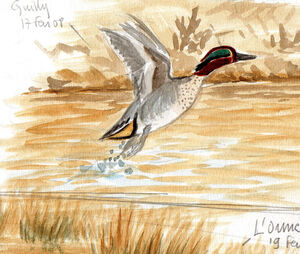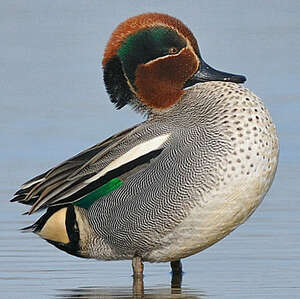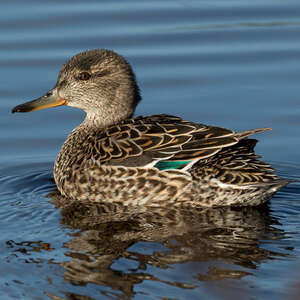Eurasian Teal
Anas crecca - Sarcelle d'hiver
Identification
The Eurasian Teal is the smallest dabbling duck of the Palearctic region. Despite its small size, it is a slender and slender bird. In addition, it is a common and gregarious bird. Sexual dimorphism is particularly marked in breeding adults. The breeding male deserves to be seen up close as the details of its plumage are subtle. The upper parts, the sides of the neck and the flanks are grey, a color produced by fine dark grey vermiculation on a cream background. The chest is cream to pink, with grey punctuations and the abdomen white without spots. The head is chestnut with a large dark green crescent on each side that encompasses the brown eye, outlines the ear and descends behind the neck. The beak is thin and very dark grey. On the side of the body, a white line highlighted by black usually appears, behind which often appears an emerald green area. Its nature is revealed on the bird in flight. Finally, as is often the case in the family, the caudal region is highlighted. Here, in lateral view, there is a chestnut cream triangle bordered by black which serves as a visual signal at the time of the nuptial parade. The legs are grey. The male in flight shows the characteristics of its wings. Firstly, in a top view is what is called the mirror at the level of the arm, common in this family. It has a white and reddish streak formed by the white and reddish tips of the large wing coverts. Just behind, the secondary remiges are colored black for the outside and green for the inside. Their white ends form a thin white trailing edge. In an underside view, one is struck by the paleness of the underside of the wing, in particular the axillaries and the large coverts are pure white. The male in eclipse has a female type plumage, so that birds in late summer, adults and young, cannot be easily sexed in the field.The adult female is very different. She is dead leaf colored like most surface ducks in order to go unnoticed at the nest. The upper parts are dark brown with creamy, beige or reddish liseret and designs. The underparts are lighter due to wider pale borders to the feathers. The head is finely spotted with brown. A faint pale eyebrow is tucked between the dark brown cap and a dark loral and post-ocular line. The beak is paler at the base than that of the male, with a yellow commissural line. The iris is brown. The wing mirror is the same as the male's. A white longitudinal stripe bordering the caudal region is quite typical. The juvenile is very similar to the adult female and can be distinguished by its spotted belly and perhaps a beak with more yellow.
Subspecific information monotypic species
Foreign names
- Sarcelle d'hiver,
- Cerceta común,
- marrequinha-eurasiática,
- Krickente,
- csörgő réce,
- Wintertaling,
- Alzavola,
- kricka,
- Krikkand,
- kačica chrapka,
- čírka obecná,
- Krikand,
- tavi,
- xarxet comú,
- Urtönd,
- cyraneczka (zwyczajna),
- krīklis,
- kreheljc,
- Чирок-свистунок,
- コガモ,
- 绿翅鸭,
- เป็ดปีกเขียว,
- 小水鴨,
Voice song and call
The usual call of the male, in particular when in flight, is a rolled, musical trut or prip repeated two or more times trut trut trut.... In groups in parade, males express themselves with flute-like pip or pup repeated regularly. Females Eurasian Teal with 4 to 7 nasally syllables going down in pitch, heet heet heet heet... or hein hein hein hein....
Habitat
In spring, the Eurasian Teal species seeks out shallow waters, particularly those located near forests and bordered by two herbaceous cover amenable to nesting.
Behaviour character trait
The Eurasian Teal is a highly social and gregarious bird, which is always found in groups outside of the breeding season.
It is quite happy to mix with other ducks, especially Mallards. It is a timorous bird, which will fly off at the slightest alarm, and it is very discreet during the nesting period. Both diurnal and nocturnal, it carries out a large portion of its feeding behaviour at dusk and during the night. When it is looking for food, it optimises its search. For instance, near a shoreline, the birds tend to spread out over the longest length possible, while still staying in contact with each other. On coastlines, they rest during high tide. Most of the breeding populations are migratory. The Teal is highly sensitive to frost and snowfall, which limits its ability to feed. Only those in a few southern regions such as the British Isles or France, remain sedentary or erratically migrating. In the month of August, it is possible to observe concentrations of several tens of birds in some overwintering areas. In ancient times, the Romans domesticated the Teal, but this practice has not lasted, probably due to the bird's character.Dietfeeding habits
In the warm season, the diet mainly consists of invertebrates such as mollusks, worms, insects and crustaceans. In winter, the diet changes; the species mainly consumes seeds of aquatic plants which it filters with its beak in shallow water and mud. Rice paddies are an ideal habitat for the Eurasian Teal in winter.
Reproduction nesting
Mating season begins in the autumn and ends in winter, when the birds wear their nuptial plumage. The courtship sites are identified by the flutelike calls that the males emit.
Courtship is typically a social affair with several males courting a single female on the water. The males are very active and vocal, and the groups often fly off together. During courtships, males display their colorful patches as a way to seduce the female and threaten rivals. They raise the feathers of their head and point the tail upwards while thinning out and uplifting the wings in a very stereotyped manner. Once paired, the partners remain together for at least seven months. Eurasian Teal reproduce from May to early June in their northernmost range. Their nest is a depression on the ground in dense vegetation or under shrubs, rarely more than 100m away from the water. The clutch size is 6-11 eggs, with 8-9 being the average. The incubation typically starts after the last egg is laid, but as the incubation period varies slightly (from 20-23 days), this is probably not always the case. The birds fledge after 25-35 days of development.Geographic range
The Eurasian Teal has a Palearctic distribution. Its range spans the entire length of the Eurasian continent, mainly at Arctic, Subarctic, and locally the north of the temperate zone. Most of the population is migratory and the wintering area is largely disjointed, except at the western tip of Europe where the climate allows sedentarity. The main wintering areas are in the south-west of Europe, around the Mediterranean Basin, in the south of Asia and in Africa, in the floodplains south of the Sahara and in the Nile axis to the east.
Threats - protection
IUCN conservation status
concern
in the Wild
threatened
evaluated
The Eurasian Teal is not threatened. Its distribution area is extremely vast and the species is common there. In Europe, the demographic trend is not known. The species is thought to be in decline, but without the population decreasing quickly enough to approach the thresholds according to the demographic trend criterion (30% decrease over ten years or three generations). For these reasons, the species is evaluated as of minor concern.
Sources of information
- IOC World Bird List (v15.1), Gill, F and D Donsker (Eds). 2025-12-07.
- Canards, cygnes et oies d'Europe, d'Asie et d'Amérique du Nord, Reeber Sébastien
- Les palmipèdes d'Europe, Géroudet P., MAJ M. Cuisin
- Wildfowl: An identification guide to the ducks geese and swans of the world, Madge, S and Burn, H
- BirdLife International, BirdLife International
- Birds of the World, The Cornell Lab of Ornithology
- xeno-canto, Sharing bird sounds from around the world,
Other sources of interest
 Specification sheet created on
17/07/2023 by Jean François
Specification sheet created on
17/07/2023 by Jean FrançoisTranslation by AI Oiseaux.net
© 1996-2025 Oiseaux.net
- Accipitriformes
- Aegotheliformes
- Anseriformes
- Apodiformes
- Apterygiformes
- Bucerotiformes
- Caprimulgiformes
- Cariamiformes
- Casuariiformes
- Charadriiformes
- Ciconiiformes
- Coliiformes
- Columbiformes
- Coraciiformes
- Cuculiformes
- Eurypygiformes
- Falconiformes
- Galliformes
- Gaviiformes
- Gruiformes
- Leptosomiformes
- Mesitornithiformes
- Musophagiformes
- Nyctibiiformes
- Opisthocomiformes
- Otidiformes
- Passeriformes
- Pelecaniformes
- Phaethontiformes
- Phoenicopteriformes
- Piciformes
- Podargiformes
- Podicipediformes
- Procellariiformes
- Psittaciformes
- Pterocliformes
- Rheiformes
- Sphenisciformes
- Steatornithiformes
- Strigiformes
- Struthioniformes
- Suliformes
- Tinamiformes
- Trogoniformes































